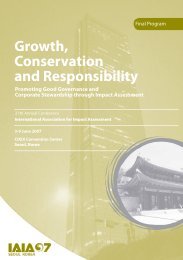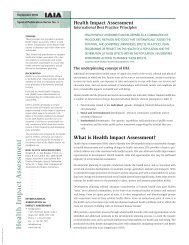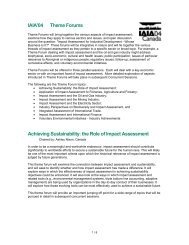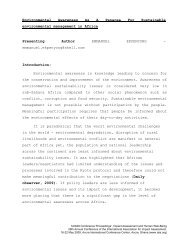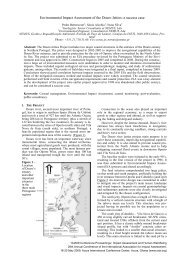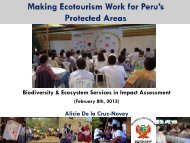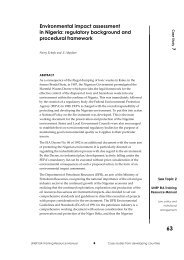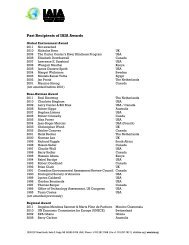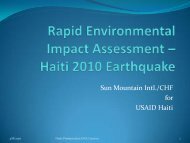Presented by: Bryony Walmsley, SAIEA Benjamin Ofosu-Koranteng ...
Presented by: Bryony Walmsley, SAIEA Benjamin Ofosu-Koranteng ...
Presented by: Bryony Walmsley, SAIEA Benjamin Ofosu-Koranteng ...
Create successful ePaper yourself
Turn your PDF publications into a flip-book with our unique Google optimized e-Paper software.
<strong>Presented</strong> <strong>by</strong>:<br />
<strong>Bryony</strong> <strong>Walmsley</strong>, <strong>SAIEA</strong><br />
<strong>Benjamin</strong> <strong>Ofosu</strong>-<strong>Koranteng</strong>, UNDP<br />
<strong>SAIEA</strong>
Hyper- endemic: 15%<br />
High Prevalence: 10-15%<br />
Low Prevalence:
• There were 1.2 million new HIV infections in ESA in 2009 (3,200 infections / day)<br />
• New infections in Mozambique are very high, but not apparent in the prevalence data<br />
• High new infections in Kenya and Uganda may reverse progress made hitherto<br />
Source: UNAIDS Estimate 2010<br />
<strong>SAIEA</strong>
)("!#$<br />
)'"!#$<br />
)&"!#$<br />
)%"!#$<br />
)!"!#$<br />
("!#$<br />
'"!#$<br />
&"!#$<br />
%"!#$<br />
!"!#$<br />
HIV prevalence among 15-24 year old<br />
women and men in Eastern and Southern<br />
Africa<br />
*+,+-+.$<br />
/01020.30-$<br />
/04-564.$<br />
7-58-90$<br />
:;2+0;10$<br />
?0;@0;50$<br />
A9;B0$<br />
C20;10$<br />
D0,5E50$<br />
/05$<br />
F5,E0E>9$<br />
/+@0,E5G49$<br />
F0,E50$<br />
H+8.>0;0$<br />
• In sub-Saharan Africa, young women aged 15–24 years are as much as eight<br />
times more likely than men to be HIV positive<br />
• Women are at higher risk of HIV infection compared to men<br />
Source: UNAIDS Estimate 2010<br />
I+48J$:K-530$<br />
L9.+8J+$<br />
I>0@5
¨<br />
¨<br />
¨<br />
¨<br />
ESA (especially Southern) epidemic is driven <strong>by</strong><br />
regional political economy – migrancy<br />
Overlay the labour migration map to the HIV map..<br />
it’s a perfect correlation<br />
Gender discrimination and labour migration<br />
inexorably linked<br />
Gender not about biology but socially ascribed and<br />
prescribed roles (customs, traditions and prejudice)<br />
<strong>SAIEA</strong>
¡ Life expectancy<br />
¡ Households<br />
¡ Healthcare<br />
¡ Schools<br />
¡ Productivity<br />
¡ Economic growth and<br />
development<br />
¡ Gender<br />
In Uganda it is estimated that<br />
epidemic has affected GDP <strong>by</strong><br />
1.2% and <strong>by</strong> 2025, the economy<br />
will be 39% smaller due to HIV<br />
<strong>SAIEA</strong>
Development<br />
interface<br />
High rate of HIV<br />
Influx of migrant<br />
workers<br />
Economic and<br />
Social impacts<br />
Construction &<br />
development of<br />
new projects<br />
Less government<br />
revenue<br />
More emphasis<br />
on economic<br />
growth<br />
<strong>SAIEA</strong>
1. Akosombo Dam, Ghana<br />
Ø 80,000 farmers displaced mostly<br />
women<br />
Ø Migrated for sex work in<br />
neighbouring countries<br />
Ø Surveillance surveys showed HIV<br />
prevalence of 5-10 times the<br />
national average in the mid 1990s<br />
and is still is<br />
2. Trans Kalahari/Caprivi<br />
Highways (Bostwana, Namibia)<br />
Ø 3 fold increase - Ghanzi district<br />
Ø Omaheke region: Fastest growing<br />
Ø Sharp HIV increase in Kavango region<br />
<strong>SAIEA</strong>
¨ Increase awareness of high-level decision makers,<br />
development planners and environmental assessment<br />
practitioners<br />
¨ Assist officials who plan, administer and manage<br />
impact assessments to also consider gender and health<br />
¨ Assist environmental assessment practitioners to work<br />
closely with NAA, MoH, and NGOs in assessing Hiv<br />
and gender impacts<br />
¨ Strengthen existing management and monitoring<br />
systems<br />
The expected outcome of this project is an enhanced<br />
ability of governments in the sub-region to integrate<br />
gender and health (particularly HIV and AIDS issues)<br />
into the management of Impact Assessment processes.<br />
<strong>SAIEA</strong>
Expected results <strong>by</strong> 2014<br />
Develop<br />
HIV, gender<br />
based<br />
guidelines<br />
Documentation<br />
and sharing of<br />
good practice<br />
Governments and its<br />
partners have been able<br />
to integrate health<br />
(particularly HIV) and<br />
AIDS gender issues into<br />
the management of<br />
Impact Assessment<br />
processes<br />
HIV and<br />
Gender<br />
sensitive<br />
legislation<br />
HIV and<br />
Gender<br />
inclusive<br />
EMPs,<br />
monitoring<br />
and<br />
compliance<br />
<strong>SAIEA</strong>
Current partnering countries<br />
8<br />
6<br />
5<br />
7<br />
3 4<br />
2<br />
1<br />
<strong>SAIEA</strong>
Project approach and phasing<br />
<strong>SAIEA</strong>
10 country reviews completed: Namibia, Lesotho, Uganda, South<br />
Africa, Malawi, Rwanda, Botswana, Zambia, Mozambique,<br />
Zimbabwe<br />
EA barometer developed<br />
5 Country pilot testing and refinement of barometer: Lesotho,<br />
Botswana, South Africa, Zambia, Uganda<br />
<strong>SAIEA</strong>
¨<br />
¨<br />
Gender<br />
¡ Some still recognise customary laws<br />
relating to birth, marriage, death,<br />
burial etc which are discriminatory<br />
against women<br />
Health<br />
¡ Most constitutions give an<br />
unalienable right to health and<br />
wellbeing<br />
¨<br />
Environment<br />
¡ Most constitutions include clauses<br />
referring to the protection of the<br />
environment<br />
<strong>SAIEA</strong>
¨<br />
All countries have EA laws, but...<br />
¡ Many different definitions of ‘environment’– few<br />
include social and health<br />
¡ Lack of consistency between constitutions,<br />
environmental laws, policies and Vision statements<br />
regarding the inclusion of health as part of the<br />
‘environment’<br />
¡ Most environmental policies date from the 1990s, so<br />
HIV does not feature<br />
¡ More recent Vision statements e.g. Botswana, Namibia,<br />
recognise HIV as a threat to sustainable development<br />
¡ Only South Africa includes gender sensitive clauses<br />
<strong>SAIEA</strong>
¨<br />
Most countries have an Inter-ministerial Committee<br />
on Environment, but...<br />
¡ Infrequent meetings<br />
¡ High turn over of members<br />
¡ Not all sectors are represented – especially health<br />
¡ Lack of accountability<br />
¡ Little active participation <strong>by</strong> members<br />
¡ Poor understanding of linkages between the environment<br />
and human wellbeing<br />
¡ Sectoralism (silo mentality)<br />
<strong>SAIEA</strong>
¨<br />
All countries have a<br />
dedicated EA agency, but..<br />
¡ Inadequate funding<br />
¡ Insufficient numbers of<br />
trained and experienced staff<br />
¡ High staff turn-over in some<br />
countries<br />
¡ Low morale in some cases<br />
¡ Relatively poor remuneration<br />
¡ Inadequate physical<br />
resources e.g. vehicles,<br />
equipment, computers, space<br />
<strong>SAIEA</strong>
¨<br />
¨<br />
¨<br />
¨<br />
¨<br />
HIV/AIDS and gender issues are seldom given<br />
adequate consideration in EAs<br />
Mitigation measures in EMPs are weak<br />
Very little, if any, compliance monitoring is undertaken,<br />
especially on issues of HIV/AIDS and gender<br />
Little appreciation of the linkages between<br />
development projects and the spread of the disease<br />
Fundamental flaws in tendering and contractual<br />
arrangements which fail to ensure HIV/AIDS, gender<br />
and other social issues are adequately addressed<br />
Development projects continue to<br />
spread the disease in spite of EIAs<br />
<strong>SAIEA</strong>
¨<br />
¨<br />
¨<br />
¨<br />
¨<br />
¨<br />
Review, harmonise and update of EA laws and<br />
policies to include social and health issues<br />
Increased advocacy of issues to policy makers and<br />
development planners<br />
Make better use of Inter-ministerial Committees to<br />
promote mainstreaming of HIV/AIDS and gender<br />
issues<br />
Develop guidelines for use <strong>by</strong> all stakeholders to<br />
ensure better inclusion of social and health issues<br />
in EAs<br />
Improve tendering and contractual procedures to<br />
make developers more accountable<br />
Extensive training and capacity building<br />
<strong>SAIEA</strong>
1. Assessing the Macro-Economic impact of HIV/AIDS in<br />
Uganda (2008)<br />
2. Botswana AIDS Impact Study (2008)<br />
3. Addressing HIV and AIDS through EIAs: Task Team<br />
Guidance for Projects in Africa: World Bank 2005<br />
4. The impact of HIV/AIDS on mining in Africa: a<br />
Botswana case study: Pula: Botswana Journal of African<br />
Studies Vol. 15 No 2 (2001)<br />
5. EIA Guidelines for transmission lines within the<br />
southern African Power Pool region: Final draft August<br />
1999<br />
6. Population Mobility and HIV: IOM<br />
<strong>SAIEA</strong>
Thank you for your attention!<br />
For further information, please contact:<br />
<strong>Benjamin</strong>: benjamin.ofosu-koranteng@undp.org<br />
<strong>Bryony</strong>: bw@saiea.co.za<br />
<strong>SAIEA</strong>


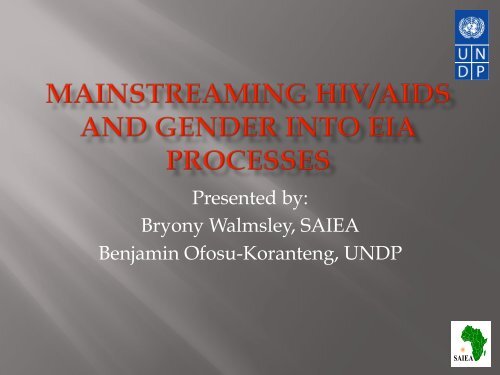

![Session Report [PDF] - International Association for Impact Assessment](https://img.yumpu.com/22416146/1/190x245/session-report-pdf-international-association-for-impact-assessment.jpg?quality=85)
![Session Report [PDF] - International Association for Impact Assessment](https://img.yumpu.com/22416140/1/184x260/session-report-pdf-international-association-for-impact-assessment.jpg?quality=85)
